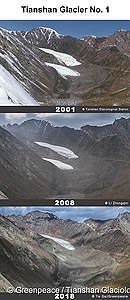Greenpeace East Asia Climate and Energy Campaigner Dr. Liu Junyan said:
“This is a wake-up call for China and the world. Glaciers in China supply water to 1.8 billion people, and they’re melting, fast. In just the last few months, thousands of people have been evacuated from their homes due to threats of flooding. Downstream, changes in water availability are impacting agriculture and cities. It is critical that we speed up the transition away from coal and other fossil fuels and keep global average temperatures at 1.5 degrees.”
Chinese Academy of Sciences research fellow Professor Shen Yongping said:
“I first visited these glaciers in 1983, and since then, have witnessed dramatic changes. Glacier melt has accelerated, and the frequency and intensity of glacial flooding have increased. The risk of glacial disasters is on track to increase sharply in the future, and there is a critical need for more glacial monitoring and protection for affected communities.”
Greenpeace analysis of satellite imagery shows that the annual rate of retreat at Laohugou Glacier No. 12, the largest in the Qilian Mountains, has more than doubled in recent decades, increasing from an average of 5.56m/year from 1959-1976 to 13.1m/year from 2006-2018.
Satellite analysis of Halong Glacier, in the Anyemaqen Mountains, Qinghai, reveals that the surface area is shrinking by 72,000 m2 per year. The glacier has retreated by 1200 meters in length over the last 30 years.
The rate of retreat at Tianshan Glacier No. 1 at the headwaters of the Urumqi River in Xinjiang has also more than doubled, from an average of 5000 m2 for the period 1962-1986 to 10,600 m2 for 1986-2018, satellite analysis shows. Between 1964 and 2018, the total area decreased by 22.2%. Due to rising temperatures, the glacier split into two parts in 1993. [2]
[Photos and video footage from Tianshan Glacier No. 1 and others available here.]
Over the past four months, Greenpeace has used satellite imagery to document two major disasters caused by glacier melt. On August 10, a Glacial Lake Outburst Flood (GLOF) occurred in the Karakorum Mountains in Xinjiang, releasing 35 million m³ of floodwater into the Yarkant River Basin and leading to the evacuation of nearby residents. On October 17, a glacier collapse released an avalanche of ice and debris into the Yarlung Zangbo River, blocking the river and leading to the evacuation of 6,600 people.
There are more than 48,000 glaciers in China, which form part of “The Third Pole,” the largest concentration of glaciers and snow outside the polar regions. Almost one-fifth of glacier area in China has already disappeared, [3] and the volume of meltwater has increased by 53.5%. [4]
Without serious action to limit the impacts of climate change, two thirds of glaciers in High Mountain Asia are projected to be gone by the end of the century. If the global temperature increase is capped at 1.5 degrees, two thirds of glaciers in High Mountain Asia can be saved. [5]
Notes to Editors:
[1] Media briefing available here (in English). Full report here (in Chinese).
Photos and video footage from this project for media use available here.
[2]

[3] Liu SY., Yao XJ., Guo WQ et al, 2015, The contemporary glaciers in China based on the Second Chinese Glacier Inventory, ACTA GEOGRAOHICA SINCA, 70(1): 3-16
[4] Ding, YJ., et al., 2017, Cold region hydrology introductory [M], Beijing: Science Press, 2017.7. p124
[5] Kraaijenbrink, P. D. A., Bierkens, M. F. P., Lutz, A. F., & Immerzeel, W. W. (2017). Impact of a global temperature rise of 1.5 degrees Celsius on Asia’s glaciers. Nature, 549, 257
Media Contacts:
Erin Newport, International Communications Officer
Greenpeace East Asia, Beijing | +86 18301149704 | [email protected]
Greenpeace International Press Desk, [email protected], phone: +31 (0) 20 718 2470 (available 24 hours)
